June 2007 LIP of the Month
Corresponds to event #21 in LIP record database.
The Manihiki Plateau: Implications for Early Cretaceous Large Igneous Province Formation in the Pacific
Stephanie Ingle
School of Ocean and Earth Science and Technology, University of Hawaii, Honolulu, Hawaii 96822, USA
Email: ingle@hawaii.edu
John J. Mahoney
School of Ocean and Earth Science and Technology, University of Hawaii, Honolulu, Hawaii 96822, USA
Hiroshi Sato
School of Business Administration, Senshu University, Kanagawa 214-8580, Japan
Millard F. Coffin
Ocean Research Institute, University of Tokyo, Tokyo 164-8639, Japan
Jun-Ichi Kimura
Department of Geoscience, Shimane University, Matsue 690-8504, Japan
Naoto Hirano
Department of Earth and Planetary Sciences, Tokyo Institute of Technology, Tokyo 152-8551, Japan
Masao Nakanishi
Graduate School of Science and Technology, Chiba University, Chiba 263-8522, Japan
Excerpted from: S Ingle, JJ Mahoney, H Sato, MF Coffin, J-I Kimura, N Hirano, & M Nakanishi, 2007: Depleted mantle wedge and sediment fingerprint in unusual basalts from the Manihiki Plateau, central Pacific Ocean. Geology 35(7) 595-598. Download pdf (597 Kb)
Introduction
Cretaceous oceanic plateau formation in the Pacific vastly exceeded that during Cenozoic time, perhaps reflecting a fundamentally different mode of mantle dynamics. Early Cretaceous (> ~100 Ma) Pacific plateaus include (see Figure 1 for locations):
- Hess Rise
- Magellan Rise
- Shatsky Rise
- Manihiki Plateau
- Ontong Java Plateau
- Hikurangi Plateau
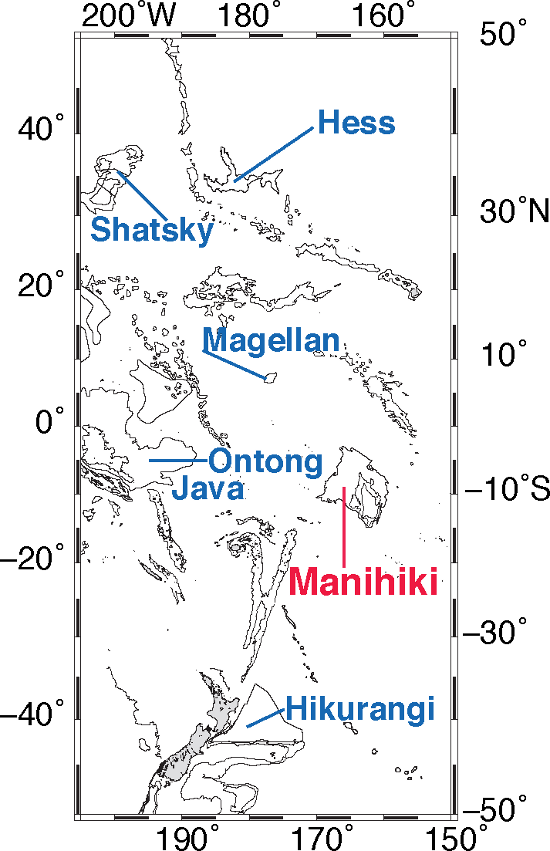
Figure 1: Locations of large western Pacific plateaus and rises.
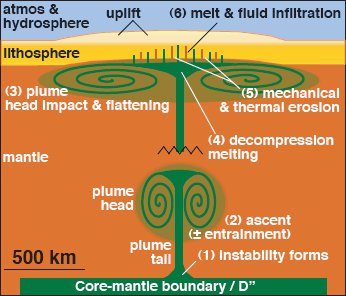
Figure 2: Plume head model for large igneous province emplacement (from Saunders et al., 1992; Richards et al., 1989).
Plateaus may form by impingement of a mantle plume head (Figure 2; e.g., Richards et al., 1989; Saunders et al., 1992). Several of the Pacific plateaus have been suggested to be products of a single “superplume” (e.g., Larson, 1991; Tatsumi et al., 1998), and recent papers have considered the possibility that three, Ontong Java, Manihiki, and Hikurangi, formed as a single enormous feature, despite their current separation by thousands of kilometers (Taylor et al., 2006; Worthington et al., 2006). If true, the area affected covered more than 1% of Earth’s surface.
Manihiki Plateau Overview
- Area of ~7.7 x 105 km2 (Coffin & Eldholm, 1994)
- Crustal thickness up to 25 km (Viso et al., 2005)
- Bisected by a series of deep troughs (Danger Islands Troughs; Winterer et al., 1974)
- Formed during Cretaceous Normal Superchron (125.0 – 83.5 Ma; Gradstein et al., 2004, time scale)
- A minimum age of Late Aptian based on biostratigraphy (Bukry, 1976)
Previous Basement (Igneous) Samplings (also see Figure 3)
- DSDP Site 317 on the ‘high plateau’ (24.5m of basement; see Figure 3; Jackson et al., 1976); tholeiitic basalts have some (isotopic) affinity to Ontong Java lavas (e.g., Mahoney & Spencer, 1991)
- Limited dredging in the Danger Islands Troughs; melt-depleted, high-Mg lavas (Clague et al., 1976) isotopically distinct from Ontong Java (Mahoney & Spencer, 1991) [herein referred to as SOTW samples]
- Limited dredging of seamounts in the eastern portion; evolved alkalic rocks (Beiersdorf et al., 1995)

Figure 3: Bathymetric map with locations of Site 317 and KH03-01 Leg 5 (D 2-4), SOTW (78D), and seamount (MWD) dredges. Strikes of the Danger Islands Troughs are indicated.
Special Note: An intensive geophysical surveying / dredging expedition of the Manihiki Plateau is occurring at present (http://www.ifm-geomar.de/index.php?id=manihiki0&L=1).
Objectives of the Study
The relationship between Manihiki, Ontong Java, and Hikurangi Plateaus is not well understood. Ages are not well-known for Manihiki (or Hikurangi), and no modern-quality incompatible-element data were available for Manihiki rocks. To attempt to remedy this:
- Four dredge hauls carried out in the Danger Islands Troughs (August, 2003); three returned igneous rocks of tholeiitic or alkalic basaltic characteristics.
- Ar-Ar dating was attempted on 8 of these samples, with two successful attempts.
- New, high-quality incompatible trace element data was obtained for Site 317, pre-existing SOTW samples, and the newly acquired samples.
- Sr, Nd, and Pb isotopic compositions of new samples were acquired.
Results
- An Ar-Ar age of 117.9 ± 3.5 Ma (2σ) for a tholeiite from the Danger Islands Troughs (Figure 4)
- An Ar-Ar age of 99.5 ± 0.7 Ma (2σ) for an alkalic lava from a seamount within the Troughs (Figure 4)
- Primitive-mantle normalized incompatible trace element patterns for Site 317 rocks are comparable to, but slightly lower than, those of the OJP Singgalo magma type rocks (Figure 5).
- Incompatible element patterns for the Danger Islands Troughs rocks are U-shaped and completely unlike those of Ontong Java or rocks from anywhere else we are aware of (Figure 5).
- Radiogenic isotopes from Site 317 are similar to Ontong Java’s Singgalo magma type, but those from the Troughs, although similar to Ontong Java’s Kwaimbaita magma type in Nd isotopes, are notably higher in 206Pb/204Pb isotopes (Figure 6).
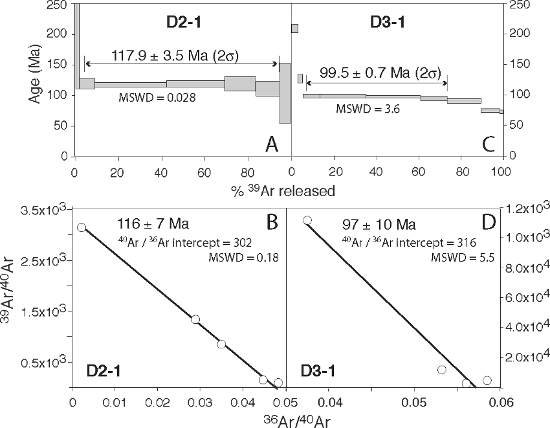
Figure 4: (A,C) apparent age vs. mole % of 39Ar released during successive incremental heating steps of 100°C. Width of horizontal bars represents the 2σ error on a measurement; arrow signifies steps used in plateau-age calculation. (B,D) Inverse isochrons for the same samples as in A,C; circles correspond to sequential steps used in plateau and isochron age calculations.

Figure 5: Primitive-mantle normalized (Sun and McDonough, 1989) incompatible element patterns of Manihiki Plateau Site 317, SOTW, and selected D2–4 samples compared with the Ontong Java’s Kwaimbaita (blue; Kroenke group; Fitton and Godard, 2004) and Singgalo (purple; Tejada et al., 1996) geochemical types.
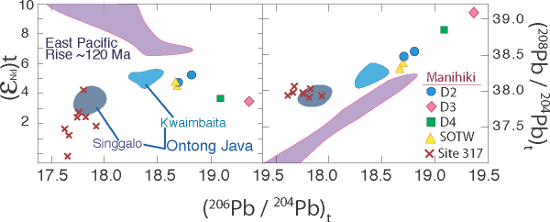
Figure 6: εNd(t) vs. (206Pb/204Pb)t and (206Pb/204Pb)t for D2–4, SOTW, Site 317, and Ontong Java rocks (Mahoney, 1987; Mahoney and Spencer, 1991; Mahoney et al. 1993; Tejada et al., 2004; Tejada et al., 1996; Tejada et al., 2002), and the southern East Pacific Rise (pink; Mahoney et al., 1994).
Interpretation of Unusual Rocks from the Danger Islands Troughs
Incompatible element patterns of the Danger Islands Troughs basalts appear to be unique among oceanic plateau, island, ridge, and arc basalts, implying a source with an atypical history. Characteristics of the source (with possible explanations in parentheses) include (see Figure 7 for additional details):
- Melting of a previously melt-depleted mantle source in the garnet-stability zone (e.g., mantle wedge beneath a subduction zone?)
- Re-enrichment of this source by a contaminant elevated in the highly incompatible elements (Rb, Th, Nb, Ta) relative to the light rare earth elements (e.g., ocean island-derived volcaniclastic sediment with high Nb/La and Ta/La transported to the mantle wedge via the subducting slab?)
- Shallow remelting of the mixed source to large extents (e.g., during initial decompression melting of a mantle plume head?)
Although the solution is non-unique (lower melting extents during step 1 may permit addition of less sediment in step 2 and less melting in step 3, or vice versa) the components and melting conditions used, provide the best fit to the available data.
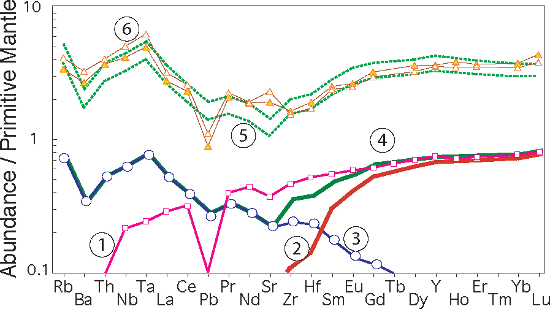
Figure 7: Model of possible melting and re-enrichment events leading to formation of the Danger Island Troughs tholeiites. 1. Starting depleted mantle (wedge) composition (Workman and Hart, 2005). 2. Residue after 15% fractional melting in the garnet-stability zone. 3. Average composition of volcaniclastic turbidites at Site 801 (Plank and Langmuir, 1998), multiplied by 0.02 to keep the left portion of the pattern within the scale of this diagram. 4. Addition of 2% of Site 801 turbidites to mantle residue. 5. Model patterns generated by 15% (upper) to 20% (lower) batch melting of the mixed source in the spinel stability zone. 6. Data for sample SOTW-11-78D-14, 15. Concentrations are normalized as in Fig. 5.
Implications for the relationship between Manihiki, Hikurangi, and Ontong Java Plateaus
The Manihiki and Ontong Java Plateaus are currently separated by ~2500 km and the HP lies ~3000 km to the south of Manihiki. Nonetheless, a relationship between two or all of these plateaus has been proposed by several authors using various lines of evidence, including age, geophysical, and geochemical data. Our data add new evidence in favor of temporal and petrogenetic connections among the three plateaus; however, they also somewhat complicate this story.
The main volcanic events on Ontong Java, Manihiki, and Hikurangi Plateaus appear to have been contemporaneous at ~120 Ma, consistent with the proposed formation of the three plateaus as a single immense feature (e.g., Billen and Stock, 2000; Mahoney and Spencer, 1991; Mortimer and Parkinson, 1996; Hoernle et al., 2005; Taylor, 2006; Worthington et al., 2006). The overlap in incompatible element characteristics and isotopic compositions is significant, but far from complete. Danger Islands Troughs tholeiites have isotopic compositions that, when combined with their distinctive trace element characteristics, reveal a component in the Manihiki Plateau mantle source not yet sampled at the other plateaus. However, Manihiki’s lava sequences are deeply exposed along the Troughs’ walls: it may be that similar rocks are yet to be found deeper in the lava stacks at Ontong Java and Hikurangi.
References
Beiersdorf, H., Bach, W., Duncan, R., Erzinger, J., and Weiss, W., 1995, New evidence for the production of EM-type ocean island basalts and large volumes of volcaniclastites during the early history of the Manihiki Plateau: Marine Geology, v. 122, p. 181-205.
Billen, M.I., and Stock, J., 2000, Morphology and origin of the Osbourn Trough: Journal of Geophysical Research, v. 105, p. 13481-13489.
Bukry, D., 1976, Cretaceous formaminiferal stratigraphy, DSDP Leg 33, Holes 315A, 316, 317A, in Schlanger, S.O., Jackson, E.D., et al., eds., Initial Reports of the Deep Sea Drilling Project 33, p. 493-501.
Clague, D.A., 1976, Petrology of basaltic and gabbroic rocks dredged from the Danger Island Troughs, Manihiki Plateau, in Schlanger, S.O., Jackson, E.D., et al., eds., Initial Reports of the Deep Sea Drilling Project 33, p. 891-907.
Coffin, M.F., and Eldholm, O., 1994, Large igneous provinces: Crustal structure, dimensions, and external consequences: Reviews of Geophysics, v. 32, p. 1-36.
Fitton, J.G., and Godard, M., 2004, Origin and evolution of magmas on the Ontong Java Plateau, in Fitton, J.G., Mahoney, J.J., Wallace, P.J., and Saunders, A.D., eds., Origin and Evolution of the Ontong Java Plateau: Geological Society (London) Special Publication 229, p. 151-178.
Gradstein, F.M., Ogg, J.G. and Smith, A., 2004. A Geologic Time Scale. Cambridge University Press, Cambridge, U.K., 589 pp.
Hoernle, K., Hauff, F., van den Bogaard, P., Werner, R., and Mortimer, N., 2005, The Hikurangi oceanic plateau: another piece of the largest volcanic event on Earth: Geochimica et Cosmochimica Acta, v. 69, p. A96.
Jackson, E.D., Bargar, K.E., Fabbi, B.P., and Heropoulos, C., 1976, Petrology of the basaltic rocks drilled on Leg 33 of the Deep Sea Drilling Project, in Schlanger, S.O., Jackson, E.D., et al., eds., Initial Reports of the Deep Sea Drilling Project 33, p. 571-630.
Larson, R.L., 1991, Latest pulse of Earth: evidence for a mid-Cretaceous superplume: Geology, v. 19, p. 547-550.
Mahoney, J.J., 1987, An isotopic survey of Pacific oceanic plateaus: implications for their nature and origin, in Keating, B.H., Fryer, P., Batiza, R., and Boehlert, G.W., eds., Seamounts, Islands, and Atolls: American Geophysical Union Geophysical Monograph 43, p. 207-220.
Mahoney, J.J., and Spencer, K.J., 1991, Isotopic evidence for the origin of the Manihiki and Ontong Java oceanic plateaus: Earth and Planetary Science Letters, v. 104, p. 196-210.
Mahoney, J.J., Storey, M., Duncan, R.A., Spencer, K.J., and Pringle, M.S., 1993, Geochemistry and age of the Ontong Java Plateau, in Pringle, M.S., Sager, W.W., Sliter, W., and Stein, S., eds., The Mesozoic Pacific. Geology, Tectonics, and Volcanism: American Geophysical Union Geophysical Monograph 77, p. 233-261.
Mahoney, J.J., Sinton, J.M., Kurz, M.D., Macdougall, J.D., Spencer, K.J., and Lugmair, G.W., 1994, Isotopic and trace element characteristics of a super-fast spreading ridge: East Pacific Rise 13-23°S: Earth and Planetary Science Letters, v. 121, p. 173-193.
Mortimer, N., and Parkinson, D., 1996, Hikuragi Plateau: a Cretaceous large igneous province in the southwest Pacific Ocean: Journal of Geophysical Research, v. 101, p. 687-696.
Plank, T., and Langmuir, C.H., 1998, The chemical composition of subducting sediment and its consequences for the crust and mantle: Chemical Geology, v. 145, p. 325-394.
Richards, M.A., Duncan, R.A., and Courtillot, V., 1989, Flood basalts and hotspot tracks: plume heads and tails: Science, v. 246, p. 103-107.
Saunders, A.D., Storey, M., Kent, R.W. and Norry, M.J., 1992. Consequences of plume-lithosphere interactions. In: B. Storey, T. Alabaster and R. Pankhurst (Editors), Magmatism and the Causes of Continental Break-up. Geological Society of America, Boulder, CO, pp. 41-60.
Sun, S.-s., and McDonough, W.F., 1989, Chemical and isotopic systematics of oceanic basalts: implications for mantle composition and processes, in Saunders, A., and Norry, M., eds., Magmatism in the Ocean Basins: Geological Society (London) Special Publication 42, p. 313-345.
Taylor, B., 2006, The single largest oceanic plateau: Ontong Java - Manihiki - Hikurangi: Earth and Planetary Science Letters, v. 241, p. 372-380.
Tejada, M.L.G., Mahoney, J.J., Duncan, R.A., and Hawkins, M.P., 1996, Age and geochemistry of basement and alkalic rocks of Malaita and Santa Isabel, Solomon Islands, Southern Margin of Ontong Java Plateau: Journal of Petrology, v. 37, p. 361-394.
Tejada, M.L.G., Mahoney, J.J., Neal, C.R., Duncan, R.A., and Petterson, M.G., 2002, Basement geochemistry and geochronology of central Malaita, Solomon Islands, with implications for the origin and evolution of the Ontong Java Plateau: Journal of Petrology, v. 43, p. 449-484.
Tejada, M.L.G., Mahoney, J.J., Castillo, P.R., Ingle, S.P., Sheth, H.C., and Weis, D., 2004, Pin-pricking the elephant: evidence on the origin of the Ontong Java Plateau from Pb-Sr-Hf-Nd isotopic characteristics of ODP Leg 192 basalts, in Fitton, J.G., Mahoney, J.J., Wallace, P.J., and Saunders, A.D., eds., Origin and Evolution of the Ontong Java Plateau: Geological Society (London) Special Publication 229, p. 133-150.
Viso, R.F., Larson, R.L., and Pockalny, R.A., 2005, Tectonic evolution of the Pacific-Phoenix-Farallon triple junction in the South Pacific Ocean: Earth and Planetary Science Letters, v. 233, p. 179-194.
Winterer, E.L., Lonsdale, P., Matthews, J.L., and Rosendahl, B.R., 1974, Structure and acoustic stratigraphy of the Manihiki Plateau: Deep-Sea Research, v. 21, p. 793-814.
Workman, R., and Hart, S., 2005, Major and trace element composition of the depleted MORB mantle (DMM): Earth and Planetary Science Letters, v. 231, p. 53-72.
Worthington, T.J., Hekinian, R., Stoffers, P., Kuhn, T., and Hauff, F., 2006, Osbourn Trough: structure, geochemistry and implications of a mid-Cretaceous paleospreading ridge in the South Pacific: Earth and Planetary Science Letters, v. 245, p. 685-701.